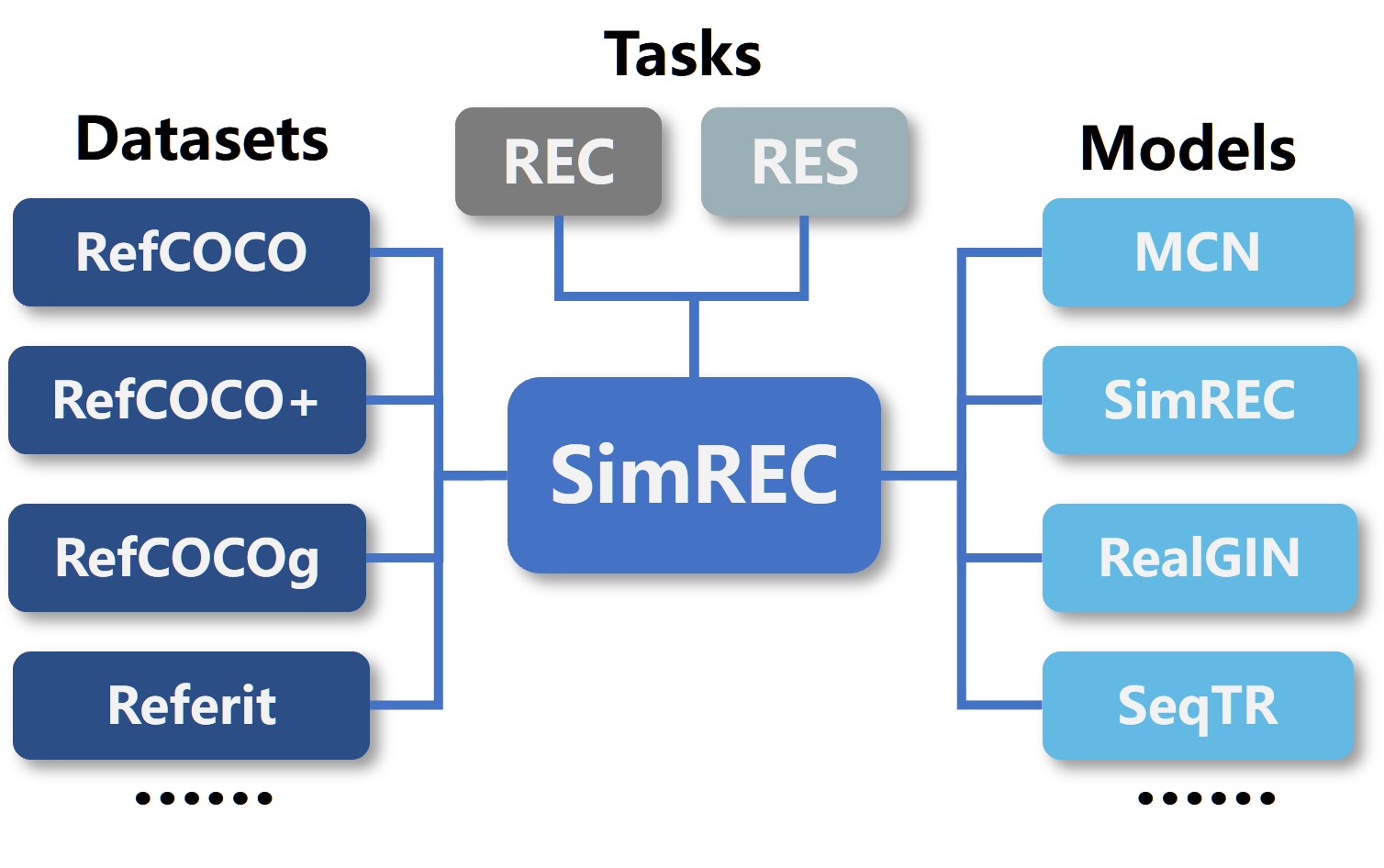SimREC is a simple and lightweight codebase for the research of referring expression comprehension and segmentation, supporting large-scale pre-training and multi-task learning. SimREC includes the official implementations of our paper "Multi-task Collaborative Network for Joint Referring Expression Comprehension and Segmentation" and "What Goes beyond Multi-modal Fusion in One-stage Referring Expression Comprehension: An Empirical Study" . More models will be updated.
- (2022/4/20) A novel point-based prediction paradigm SeqTR is released in here, which will be updated in this repository.
- (2022/4/20) Implement MCN for SimREC project.
- (2022/4/19) Release our SimREC project.
- Clone this repo
git clone https://github.com/luogen1996/SimREC.git
cd SimREC- Create a conda virtual environment and activate it
conda create -n simrec python=3.7 -y
conda activate simrec- Install Pytorch following the official installation instructions
- Install mmcv following the installation guide
- Install Spacy and initialize the GloVe and install other requirements as follows:
pip install -r requirements.txt
wget https://github.com/explosion/spacy-models/releases/download/en_vectors_web_lg-2.1.0/en_vectors_web_lg-2.1.0.tar.gz -O en_vectors_web_lg-2.1.0.tar.gz
pip install en_vectors_web_lg-2.1.0.tar.gz
- Follow the instructions of DATA_PRE_README.md to generate training data and testing data.
- Download the pretrained weights of backbone (vgg, darknet, cspdarknet, DResNet, etc.). Expect for DResNet, all pretrained backbones are trained on COCO 2014 train+val set while removing the images appeared in the val+test sets of RefCOCO, RefCOCO+ and RefCOCOg (nearly 6500 images). Please follow the instructions of DATA_PRE_README.md to download them.
- Config preparation. Prepare your own configs in configs, you don't need to rewrite all the contents in config every time.You can import the config as a python file to use the default configs in configs/common as follows:
# your own config.py
from simrec.config import LazyCall
from .common.dataset import dataset
from .common.train import train
from .common.optim import optim
from .common.models.simrec import model
# modify the config depend your own need
dataset.ann_path["refcoco"] = "path/to/refcoco_data"
train.output_dir = "./path/to/output_dir"
...- Train the model. Run
bash/train.shunder the tools to start training, for example, trainingsimrecmodel on 4 GPUs:
bash tools/train.sh config/simrec_refcoco_scratch.py 4The training logs, tensorboard logs, config.yaml and model checkpoints will be automatically saved under cfg.train.output_dir.
- Resume training. We support two resume training mode. You can resume from a specific checkpoint or resume from the latest checkpoint:
- Auto resume from
last_checkpoint.pth:
# config.py
from .common.train import train
train.auto_resume.enabled = TrueSetting train.auto_resume.enabled=True, which will automatically resume from last_checkpoint.pth saved in cfg.train.output_dir.
- Resume from a specific checkpoint
# config.py
from .common.train import train
# disable auto resume first
train.auto_resume.enabled = False
# modify the resume path
train.resume_path = "path/to/specific/checkpoint.pth"Setting train.resume_path to the specific checkpoint.pth you want to resume from.
- Test the model. Run
bash/eval.shunder tools to evaluate the saved weight.
bash tools/eval.sh config/simrec_refcoco_scratch.py 4 /path/to/checkpointSimREC supports all benchmarks of REC and RES, and can easily achieve very competitive performance. More results are available in Model Zoo.
| Tasks | RefCOCO | RefCOCO+ | RefCOCOg | Referit | Flickr | All REC data + VG (0.2M) |
|---|---|---|---|---|---|---|
| REC | ✓ | ✓ | ✓ | ✓ | ✓ | ✓ |
| RES | ✓ | ✓ | ✓ | ✓ | × | × |
| REC+RES | ✓ | ✓ | ✓ | ✓ | × | × |
This project is released under the Apache 2.0 license.
If this repository is helpful for your research, or you want to refer the provided results in your paper, consider cite:
@article{luo2022what,
title={What Goes beyond Multi-modal Fusion in One-stage Referring Expression Comprehension: An Empirical Study},
author={Luo, Gen and Zhou, Yiyi and Sun, Jiamu and Huang, Shubin and Sun, Xiaoshuai and Ye, Qixiang and Wu, Yongjian and Ji, Rongrong},
journal={arXiv preprint arXiv:2204.07913},
year={2022}
}@article{zhu2022seqtr,
title={SeqTR: A Simple yet Universal Network for Visual Grounding},
author={Zhu, Chaoyang and Zhou, Yiyi and Shen, Yunhang and Luo, Gen and Pan, Xingjia and Lin, Mingbao and Chen, Chao and Cao, Liujuan and Sun, Xiaoshuai and Ji, Rongrong},
journal={arXiv preprint arXiv:2203.16265},
year={2022}
}@InProceedings{Luo_2020_CVPR,
author = {Luo, Gen and Zhou, Yiyi and Sun, Xiaoshuai and Cao, Liujuan and Wu, Chenglin and Deng, Cheng and Ji, Rongrong},
title = {Multi-Task Collaborative Network for Joint Referring Expression Comprehension and Segmentation},
booktitle = {Proceedings of the IEEE/CVF Conference on Computer Vision and Pattern Recognition (CVPR)},
month = {June},
year = {2020}
}@inproceedings{luo2020cascade,
title={Cascade grouped attention network for referring expression segmentation},
author={Luo, Gen and Zhou, Yiyi and Ji, Rongrong and Sun, Xiaoshuai and Su, Jinsong and Lin, Chia-Wen and Tian, Qi},
booktitle={Proceedings of the 28th ACM International Conference on Multimedia},
pages={1274--1282},
year={2020}
}@article{zhou2021real,
title={A real-time global inference network for one-stage referring expression comprehension},
author={Zhou, Yiyi and Ji, Rongrong and Luo, Gen and Sun, Xiaoshuai and Su, Jinsong and Ding, Xinghao and Lin, Chia-Wen and Tian, Qi},
journal={IEEE Transactions on Neural Networks and Learning Systems},
year={2021},
publisher={IEEE}
}@misc{luo2022simrec,
author = {Gen Luo and Tianhe Ren},
title = {SimREC},
howpublished = {\url{https://github.com/luogen1996/SimREC}},
year = {2022}
}Thanks a lot for the nicely organized code from the following repos



